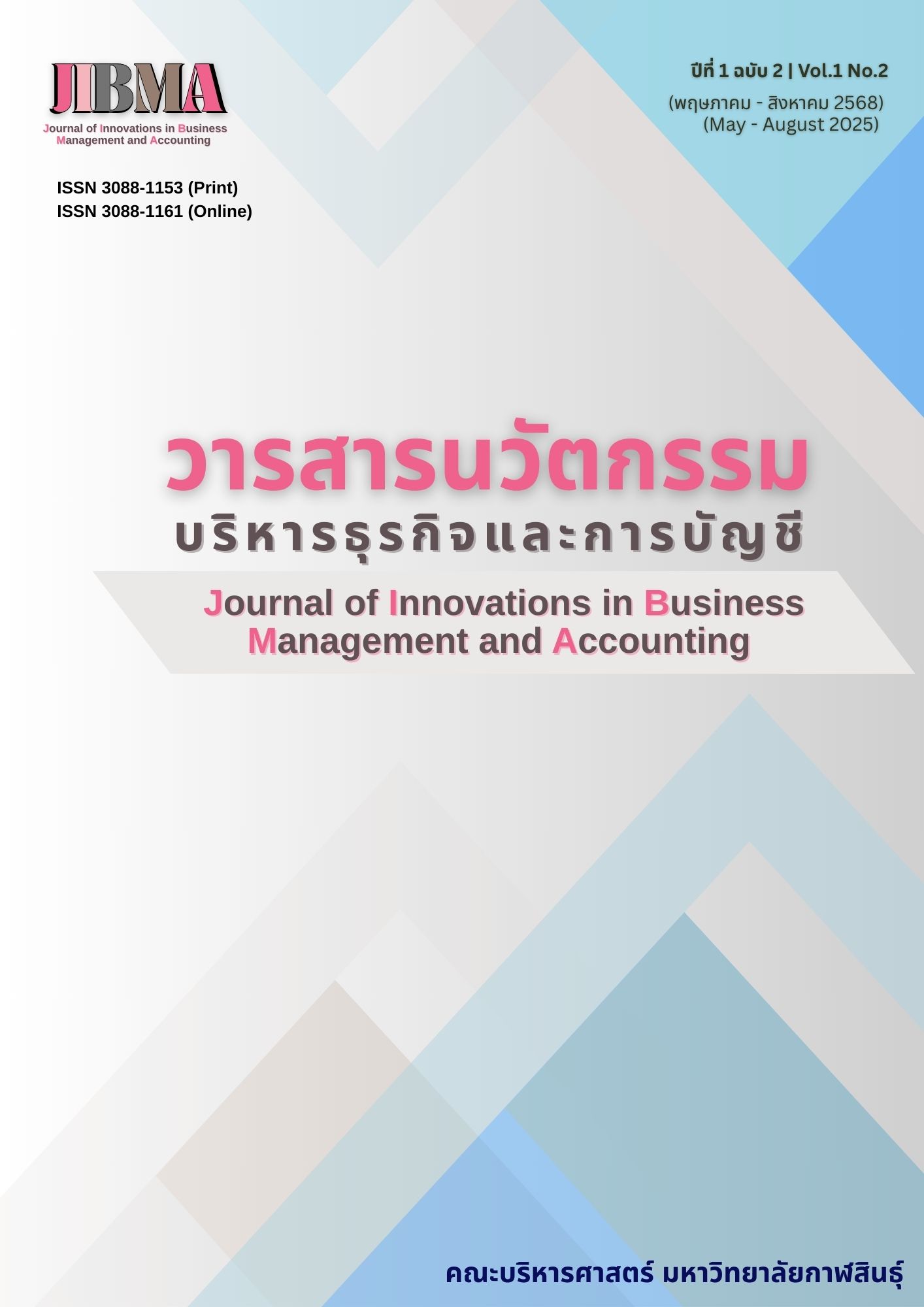A Study on the Marketing Opportunities of Silk Products by the Ban Phon Sawang Silk Weaving Group, Namakuea Subdistrict, Sahatsakhan District, Kalasin Province
Keywords:
Marketing Opportunities, Silk Products, Ban Phon Sawang Silk Weaving Women GroupAbstract
The objective of this study was to examine the context and marketing opportunities of the silk weaving group and the Ban Phon Sawang silk weaving group in Namakuea Subdistrict, Sahatsakhan District, Kalasin Province. This quantitative research employed questionnaires as the data collection tool, surveying members of the groups. The statistical methods used for data analysis included frequency, percentage, mean, and standard deviation.The results revealed that the Ban Phon Sawang silk weaving group consisted of 17 members, all female, aged between 41 and 50 years old, with education at the primary school level. Their weaving experience ranged from 11 to 15 years, and their monthly income was below 10,000 baht.The identified marketing opportunities for the group include: Government initiatives promoting Thai cultural trends and encouraging the nationwide use of Thai textiles.Kalasin Province’s policy to integrate traditional silk weaving wisdom into the market. Activities organized to pay tribute to the King and the royal family. Government campaigns advocating for the public to wear local textiles, such as the provision of investment liquidity support to silk producers to strengthen and support exports. Currently, the volume of silk produced is sufficient to meet consumer demand. It is recommended that the group’s silk products be incorporated into the mulberry-silk agricultural product management system. Additionally, the design, color, and patterns of the silk should be modernized to align with consumer preferences. Introducing new technologies to silk producers will help adapt to evolving market trends.
Downloads
References
กมลลักษณ์ ชิ้นทอง, ณภัสวรรณ ศาลางาม, และ สิริวิมล ภาสุวรรณ. (2567). การต่อยอดและพัฒนาผ้าไหมของกลุ่มทอผ้าไหม บ้านป่ายาว ตำบลจารพัต อำเภอศีขรภูมิจังหวัดสุรินทร์. วารสารวิชาการเพื่อพัฒนาท้องถิ่น, 3(1), 11–26. https://doi.org/10.14456/ajld.2024.2
จงกล ผิวดำ. (2549). ปัจจัยที่มีอิทธิพลต่อการตัดสินใจซื้อผลิตภัณฑ์ผ้าไหมของข้าราชการ กรณีศึกษา: อำเภอเมือง จังหวัดกระบี่. [วิทยานิพนธ์บริหารธุรกิจมหาบัณฑิตไม่ได้ตีพิมพ์]. มหาวิทยาลัยราชภัฏภูเก็ต.
ธนพล คล้ายรักษ์. (2551). พฤติกรรมและการตัดสินใจเลือกซื้อผ้าไหมของผู้บริโภค ในจังหวัดพระนครศรีอยุธยา. [วิทยานิพนธ์บริหารธุรกิจมหาบัณฑิตไม่ได้ตีพิมพ์]. มหาวิทยาลัยราชภัฎพระนครศรีอยุธยา.
ธีรพงษ์ วสันตดิลก. (2546). รูปแบบการพัฒนาตลาดผ้าไหมและผลิตภัณฑ์ไหมจังหวัดบุรีรัมย์. [วิทยานิพนธ์ ศิลปศาสตรมหาบัณฑิตไม่ได้ตีพิมพ์]. มหาวิทยาลัยราชภัฎบุรีรัมย์.
วัชระ ยี่สุ่นเทศ และ ชนิกานต์ พนมอุปถัมภ์. (2563). โอกาสทางการตลาดของผลิตภัณฑ์ป่านศรนารายณ์. วารสารราชภัฏเพชรบูรณ์สาร, 22(1), 63-76.
วัฒนะ จูฑะวิภาต. (2555). ผ้าทอกับชีวิตคนไทย. รายงานการวิจัย. มหาวิทยาลัยธุรกิจบัณฑิตย์.
วิภาวี สีลากุล และ รุ่งนภา กิตติลาภ. (2559). ปัจจัยที่มีผลต่อการดำเนินงานของกลุ่มผู้ทอผ้าไหมมัดหมี่ในจังหวัดขอนแก่น. วารสารวิชาการธรรมทรรศน์, 16(2), 13–22.
สถาบันพัฒนาอุตสาหกรรมสิ่งทอ. (2561). รายงานสถานการณ์อุตสาหกรรมสิ่งทอและเครื่องนุ่งห่มไทย เดือนมกราคม 2561. https://thaitextile.org/th/insign/detail.410.1.0.html.
อาริยา หุ่นวงศ์ษา. (2560). การส่งเสริมกลุ่มอาชีพผ้าไหมไทย. วารสารสถาบันวิจัยและพัฒนา มหาวิทยาลัยราชภัฏมหาสารคาม, 4(1), 53-64.
Downloads
Published
Issue
Section
License
Copyright (c) 2025 Journal of Innovations in Business Management and Accounting

This work is licensed under a Creative Commons Attribution-NonCommercial-NoDerivatives 4.0 International License.
ต้องใส่ข้อความลิขสิทธิ์





